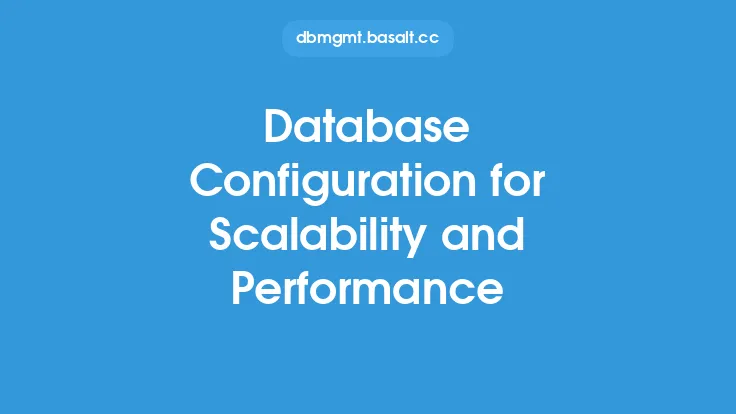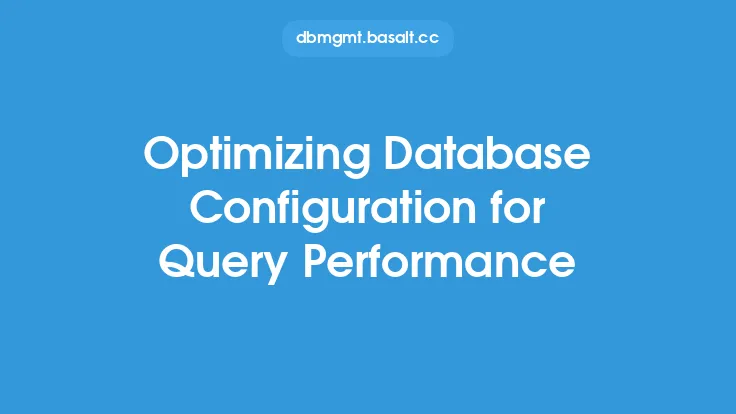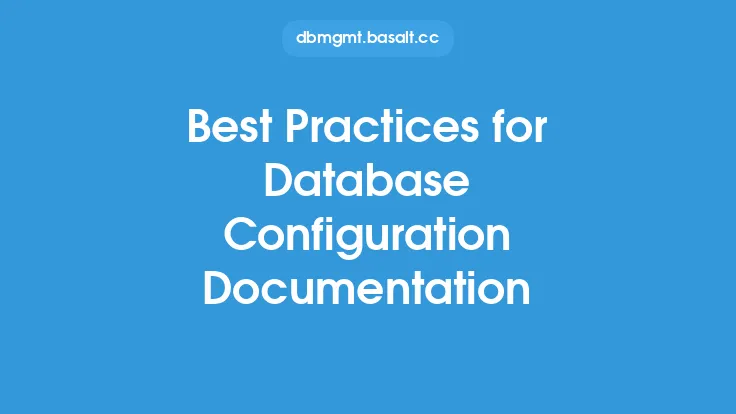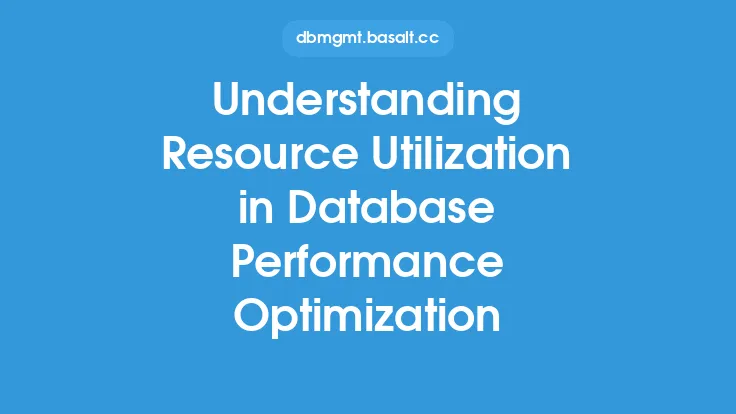Database configuration parameters play a crucial role in determining the performance of a database system. These parameters control various aspects of database behavior, such as memory allocation, disk I/O, and query execution. Proper configuration of these parameters can significantly enhance database performance, while incorrect or suboptimal configuration can lead to performance degradation, increased latency, and even system crashes. In this article, we will delve into the world of database configuration parameters, exploring their significance, types, and best practices for optimization.
Introduction to Database Configuration Parameters
Database configuration parameters are settings that control the behavior of a database management system (DBMS). These parameters can be categorized into several types, including memory-related parameters, disk I/O parameters, query execution parameters, and security-related parameters. Each parameter has a specific purpose and can significantly impact database performance. For instance, memory-related parameters, such as buffer cache size and shared pool size, control the amount of memory allocated to the database for caching data and executing queries. Disk I/O parameters, such as disk block size and I/O timeout, regulate the interaction between the database and disk storage. Query execution parameters, such as optimizer mode and query timeout, influence the execution of queries and the optimization of query plans.
Types of Database Configuration Parameters
There are several types of database configuration parameters, each with its own set of sub-parameters and settings. Some of the most common types of parameters include:
- Memory-related parameters: These parameters control the allocation of memory to the database, including buffer cache size, shared pool size, and large pool size.
- Disk I/O parameters: These parameters regulate the interaction between the database and disk storage, including disk block size, I/O timeout, and disk queue size.
- Query execution parameters: These parameters influence the execution of queries, including optimizer mode, query timeout, and cursor cache size.
- Security-related parameters: These parameters control access to the database, including authentication mode, authorization mode, and encryption settings.
- Network-related parameters: These parameters regulate communication between the database and client applications, including network protocol, port number, and connection timeout.
Best Practices for Configuring Database Parameters
Configuring database parameters requires careful consideration of several factors, including database workload, hardware resources, and performance requirements. Here are some best practices for configuring database parameters:
- Monitor database performance: Regularly monitor database performance to identify bottlenecks and areas for improvement.
- Analyze database workload: Analyze database workload to determine the optimal configuration of parameters, such as memory allocation and disk I/O settings.
- Follow vendor recommendations: Follow vendor recommendations for parameter settings, as these are often based on extensive testing and tuning.
- Test and validate: Test and validate parameter settings to ensure they do not introduce performance regressions or other issues.
- Document configuration: Document database configuration, including parameter settings and changes, to facilitate troubleshooting and maintenance.
Advanced Database Configuration Parameters
Some database configuration parameters are more advanced and require specialized knowledge to configure correctly. These parameters include:
- Parallel query parameters: These parameters control the execution of parallel queries, including parallel query mode, parallel query degree, and parallel query timeout.
- Partitioning parameters: These parameters control the partitioning of large tables, including partitioning mode, partitioning key, and partitioning size.
- Indexing parameters: These parameters control the creation and maintenance of indexes, including index mode, index type, and index size.
- Statistics collection parameters: These parameters control the collection of database statistics, including statistics collection mode, statistics collection frequency, and statistics retention period.
Database Configuration Parameter Tuning Tools
Several tools are available to help tune database configuration parameters, including:
- Database management system (DBMS) built-in tools: Most DBMSs provide built-in tools for monitoring and tuning database performance, including parameter configuration.
- Third-party tuning tools: Several third-party tools are available for tuning database configuration parameters, including tools from vendors such as Oracle, IBM, and Microsoft.
- Open-source tuning tools: Open-source tools, such as PostgreSQL's pg_tune and MySQL's mysqltuner, are also available for tuning database configuration parameters.
Common Database Configuration Parameter Mistakes
Several common mistakes can be made when configuring database parameters, including:
- Insufficient memory allocation: Failing to allocate sufficient memory to the database can lead to performance degradation and increased latency.
- Incorrect disk I/O settings: Incorrect disk I/O settings, such as disk block size and I/O timeout, can lead to poor disk performance and increased latency.
- Suboptimal query execution parameters: Suboptimal query execution parameters, such as optimizer mode and query timeout, can lead to poor query performance and increased latency.
- Inadequate security settings: Inadequate security settings, such as authentication mode and authorization mode, can lead to security vulnerabilities and data breaches.
Conclusion
Database configuration parameters play a critical role in determining the performance of a database system. Proper configuration of these parameters can significantly enhance database performance, while incorrect or suboptimal configuration can lead to performance degradation, increased latency, and even system crashes. By understanding the types of database configuration parameters, following best practices for configuration, and using advanced tuning tools, database administrators can optimize database performance and ensure the reliability and security of their database systems.





